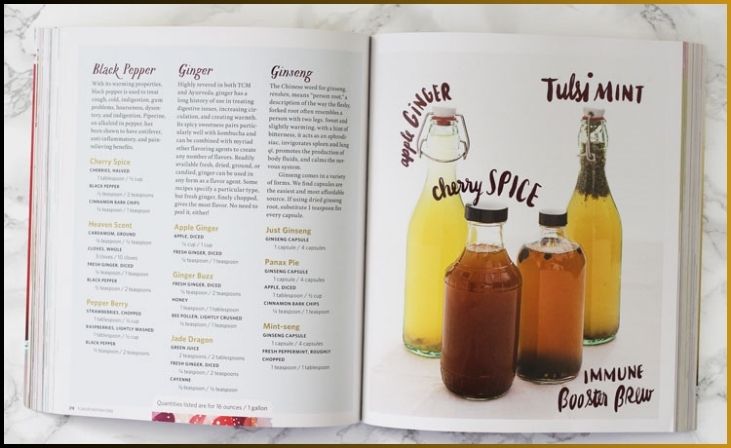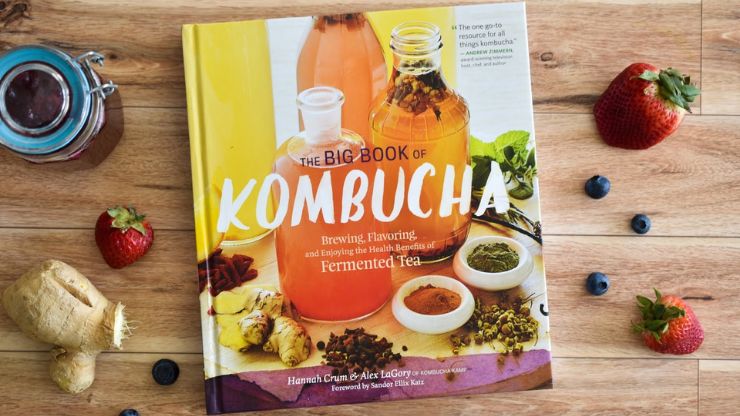Do you make kombucha? If you do and struggle with it, or if you don’t make kombucha because you’re not quite sure if it’s safe or easy, read this post. Chris’ review of The Big Book of Kombucha will prompt you to read the book. And from there, you will be a kombucha aficionado.
I’ve read a few kombucha books in the past few years and this new book by Hannah Crum and Alex LaGory is my favorite so far. The Big Book of Kombucha: Brewing, Flavoring, and Enjoying the Health Benefits of Fermented Tea (Storey, 2016) is the go-to reference book for kombucha. If you make your own kombucha at home, this book will answer all your questions and ponderings about this ancient fermented drink.
Let me cover just a few of the important questions that The Big Book of Kombucha addresses.
Table of Contents
ToggleWhat kind of sugar can I use in Kombucha?
According to Crum and LaGory, you can use the following sweeteners in your kombucha:
- Evaporated cane juice
- Plain white sugar
- Cane sugar
- Turbinado sugar
- Maple syrup
- Pasteurized honey
Other sweeteners should be used only on an experimental basis when you have additional scobies in reserve to replace any that are weakened in the experiment.
What kind of tea should I use in Kombucha?
- Black tea
- Oolong tea
- Green tea
- White tea
- Pu-erh tea
- White tea
Variations of these teas come from the Camellia sinensis plant.
Quick Link: Book Review Art of Natural Cheesemaking
Can I add herbs to my kombucha brew in the first ferment?
Herbs can make up 25% of your kombucha brew with tea (from Camellia sinensis) making up at least 75% of the batch. But wait to add herbs to your primary ferment until you have a few extra copies saved up in a SCOBY hotel. Sometimes adding herbs can weaken your scoby.
Some herbs to try in kombucha:
Cinnamon can be added in small amounts, such as a few cinnamon sticks or a little cinnamon powder to a batch of brewed tea. Cinnamon adds vitality to the brew while softening the sharpness of the tannins.
Ginger can be added, but limit it to 5% of the total. Use fresh grated root in the first ferment which adds nutrients to the brew that the scoby thrives with.
Hibiscus lends a nice tartness to the brew and gives a pleasing pink color to the scoby. Use up to 20 % hibiscus flowers in the primary fermentation.
Rooibos and honeybush can be used in up to 25% of the tea in primary fermentation.
Yerba Mate can be added to up to 25% of the tea in a primary fermentation.
Don't just scroll, subscribe!
BuzzTrail's unique web-stories are the cure for boredom you've been waiting for.
Ayurvedic and Traditional Chinese Medicinal herbs can be added at a rate of 25% and can add complex flavors and additional benefits. Some herbs to try include angelica, ashwagandha, astragalus, ginkgo, ginseng, gotu kola, and turmeric. Avoid herbs that are highly aromatic. These herbs are often antimicrobial and can weaken the scoby. Highly aromatic herbs include mint, rosemary, lemon balm, lavender, anise hyssop, and fennel seed, to name a few. These herbs may be better saved for the second ferment. Always have a few copies in reserve in case an experimental batch of herbal tea weakens the scoby too much, and you need to replace it in subsequent batches.
What environmental conditions can cause problems with kombucha brewing?
Since the kombucha brewing vessel is an aerobic environment, the air quality that surrounds your fermentation vessel is important. Here are a few things you should avoid in the environment of your kombucha brewing vessel:
- Direct sunlight
- Nearness to other ferments
- Excessive temperatures
- Harsh perfume or chemical fumes
- Cigarette smoke
- Pollen
- Cooking fumes like onions, garlic, or smoke
What vitamins and nutrients does kombucha contain?
Kombucha contains vitamin C, thiamine, riboflavin, B6, B12, and K, plus the scoby contains all 9 essential amino acids that make a complete protein. (The book includes recipes for using the scoby as a protein source.)
What’s in The Big Book of Kombucha?

If you are brewing your own kombucha, or even if you’re buying bottled kombucha and just beginning to explore making your own book, you’ll get a lot of valuable information from The Big Book of Kombucha. Besides answering the basic questions and offering the history and methodology of kombucha making, this book is full of recipes for unusual and tested second-ferment flavor inspirations.
This section of the book is divided into fruit recipes, herbal recipes, superfoods, savory (bacon kombucha, anyone?), and medicinal second ferments. Each section is an A to Z listing that includes recipes with measurements given for 16-ounce and 1-gallon batches, so you can easily double the recipe. If you are getting bored with the same old pomegranate kombucha and looking for some excitement, there are flavor samplers here for many batches of fizzy kombucha.
Included in this great resource are other beverages, like sangria, shrubs, and cocktails. There are also recipes for kombucha condiments like ketchup, mustard, and salad dressing. Try using kombucha vinegar for refrigerator pickles, dilly beans, and salads. And if you’ve been wondering how to use up those kombucha scobies that are spreading out increasingly in those kombucha hotels, there’s an entire section on cooking with scabies, including recipes for “Scoby squid sashimi” and scoby fruit leather.
The photography in this book is exceptionally beautiful. The book design is inviting while keeping the type very readable. This would be a lovely gift book for those who drink bottled kombucha and might want to try a DIY version. The experienced kombucha brewer would also find a lot of useful and enlightening information in this book.
The Big Book of Kombucha is a good addition to your fermentation library. You’ll be referring to it again and again as you expand your kombucha brewing repertoire. Inspired by the book, I’m eagerly waiting for the wild rose buds to open so that I can make a batch of rose petals and elderberry kombucha to sip on those warm summer afternoons.
I bought my copy of this book at Costco. You can also find it on Amazon.
Final Words
“The Big Book of Kombucha” is a comprehensive and invaluable resource for anyone interested in brewing, flavoring, and enjoying the health benefits of kombucha. With its detailed instructions, flavorful recipes, and insightful tips, this book equips both beginners and experienced brewers with the knowledge and inspiration to create delicious and nourishing kombucha at home. Whether you’re looking to expand your kombucha repertoire or embark on a new fermentation adventure, “The Big Book of Kombucha” is a must-have guide that will elevate your kombucha brewing skills and enhance your enjoyment of this ancient and healthful beverage.
FAQs
What sets “The Big Book of Kombucha” apart from other guides on Kombucha brewing?
What sets “The Big Book of Kombucha” apart from other guides on Kombucha brewing?
This book stands out for its extensive coverage, providing a deep dive into the world of Kombucha brewing. From detailed brewing techniques to a wide array of flavoring options, it serves as a comprehensive resource for both beginners and experienced brewers.
Is this book suitable for beginners looking to start their Kombucha journey?
Is this book suitable for beginners looking to start their Kombucha journey?
Absolutely! “The Big Book of Kombucha” caters to all skill levels, offering step-by-step instructions and practical tips for those new to brewing. It guides beginners through the entire process, making Kombucha brewing accessible and enjoyable.
Does the book explore the health benefits of Kombucha, and does it address common misconceptions about this fermented tea?
Does the book explore the health benefits of Kombucha, and does it address common misconceptions about this fermented tea?
Yes, the book delves into the health benefits of Kombucha, providing insights into its probiotic properties and potential impact on gut health. It also dispels common myths and misconceptions, offering a well-rounded understanding of Kombucha’s role in promoting well-being.
Are there creative recipes for flavoring Kombucha, and does the book cover troubleshooting tips for common brewing issues?
Are there creative recipes for flavoring Kombucha, and does the book cover troubleshooting tips for common brewing issues?
“The Big Book of Kombucha” features a multitude of creative recipes for flavoring, allowing brewers to customize their Kombucha experience. Additionally, the book includes troubleshooting sections, helping readers navigate common challenges and ensuring successful and delicious batches.

